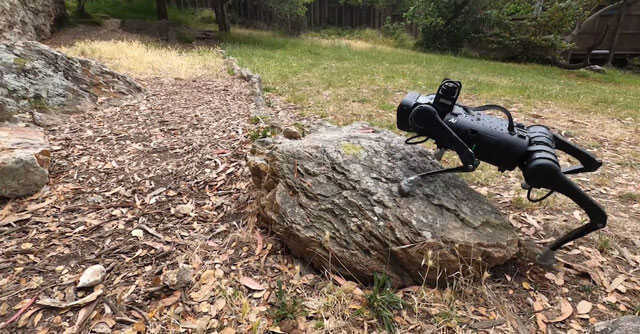
Researchers build a four-legged robot that can climb stairs, hills


Researchers at Carnegie Mellon University and the University of California, Berkeley have built a robotic system that can move freely on uneven surfaces including stairs, sidewalks, hilly terrain, and climb over big rocks. It addresses a major limitation in most modern-day robots, which require a smooth surface to operate freely.
Pictures of the robotic system, published by Carnegie Mellon University in a blog post, show a four-legged robot climbing a rock. Its design was inspired by the movement of hind legs in four-legged animals, according to the researchers. “Four-legged animals have a memory that enables their hind legs to track the front legs. Our system works in a similar fashion,” said Deepak Pathak, an assistant professor at the Robotics Institute, Carnegie Mellon University.
The system's memory allows the rear legs to remember what the camera saw and alter its movement accordingly to avoid obstacles. It has also been trained to imitate human-like hip movements for more clearance when it has to lift its legs to climb stairs or a ledge, they added.

The researchers claim that the robot has been trained with 4,000 of its clones in a simulator, where challenging terrain such as uneven stairs, hillsides, and slippery surfaces was recreated for it to practice walking and climbing. The simulator allows the robot to gain six years of walking experience in different terrains in a single day, the researchers added.
The motor skills used to train the simulator in a neural network were also transferred to the robotic system.
Unlike most robotic systems that use cameras to map the environment for obstacles and then rely on a self-generated map to plan its movement, Carnegie Mellon’s robotic system does not rely on mapping and advanced planning. The input from its cameras is directly transferred to the control of the robot so it can plan its movement in real-time based on what it is seeing.

“This technique allows the system to be very robust in the real world. If it slips on the stairs, it can recover. It can go into unknown environments and adapt,” said Ananye Agarwal, a Ph.D. student in machine learning at the School of Computer Science, Carnegie Mellon University.
The researchers claim that the system of mapping used in most modern-day commercial robots is slow and prone to inaccuracies in the mapping stage, which can impact its operations. Hence, they are not reliable in dynamic environments which require skills like walking or running over uneven terrains.
They further noted that since the robotic system doesn't use any mapping technology like Lidar, it can be built at a much lower cost. The system built for the research cost 25 times less than commercially available robots, they added.

